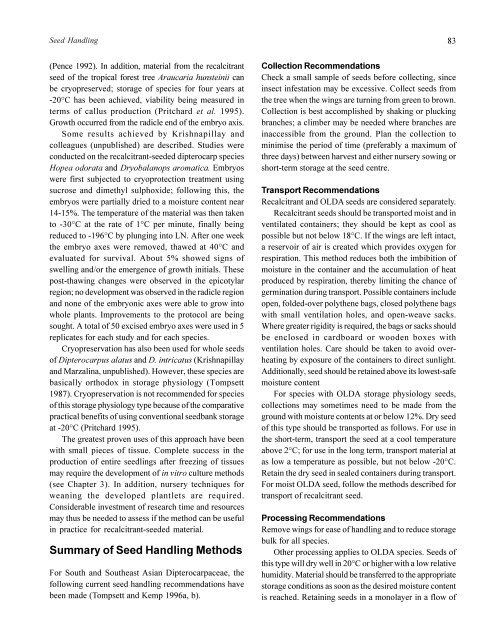A review of dipterocarps - Center for International Forestry Research
A review of dipterocarps - Center for International Forestry Research
A review of dipterocarps - Center for International Forestry Research
Create successful ePaper yourself
Turn your PDF publications into a flip-book with our unique Google optimized e-Paper software.
Seed Handling 83<br />
(Pence 1992). In addition, material from the recalcitrant<br />
seed <strong>of</strong> the tropical <strong>for</strong>est tree Araucaria hunsteinii can<br />
be cryopreserved; storage <strong>of</strong> species <strong>for</strong> four years at<br />
-20°C has been achieved, viability being measured in<br />
terms <strong>of</strong> callus production (Pritchard et al. 1995).<br />
Growth occurred from the radicle end <strong>of</strong> the embryo axis.<br />
Some results achieved by Krishnapillay and<br />
colleagues (unpublished) are described. Studies were<br />
conducted on the recalcitrant-seeded dipterocarp species<br />
Hopea odorata and Dryobalanops aromatica. Embryos<br />
were first subjected to cryoprotection treatment using<br />
sucrose and dimethyl sulphoxide; following this, the<br />
embryos were partially dried to a moisture content near<br />
14-15%. The temperature <strong>of</strong> the material was then taken<br />
to -30°C at the rate <strong>of</strong> 1°C per minute, finally being<br />
reduced to -196°C by plunging into LN. After one week<br />
the embryo axes were removed, thawed at 40°C and<br />
evaluated <strong>for</strong> survival. About 5% showed signs <strong>of</strong><br />
swelling and/or the emergence <strong>of</strong> growth initials. These<br />
post-thawing changes were observed in the epicotylar<br />
region; no development was observed in the radicle region<br />
and none <strong>of</strong> the embryonic axes were able to grow into<br />
whole plants. Improvements to the protocol are being<br />
sought. A total <strong>of</strong> 50 excised embryo axes were used in 5<br />
replicates <strong>for</strong> each study and <strong>for</strong> each species.<br />
Cryopreservation has also been used <strong>for</strong> whole seeds<br />
<strong>of</strong> Dipterocarpus alatus and D. intricatus (Krishnapillay<br />
and Marzalina, unpublished). However, these species are<br />
basically orthodox in storage physiology (Tompsett<br />
1987). Cryopreservation is not recommended <strong>for</strong> species<br />
<strong>of</strong> this storage physiology type because <strong>of</strong> the comparative<br />
practical benefits <strong>of</strong> using conventional seedbank storage<br />
at -20°C (Pritchard 1995).<br />
The greatest proven uses <strong>of</strong> this approach have been<br />
with small pieces <strong>of</strong> tissue. Complete success in the<br />
production <strong>of</strong> entire seedlings after freezing <strong>of</strong> tissues<br />
may require the development <strong>of</strong> in vitro culture methods<br />
(see Chapter 3). In addition, nursery techniques <strong>for</strong><br />
weaning the developed plantlets are required.<br />
Considerable investment <strong>of</strong> research time and resources<br />
may thus be needed to assess if the method can be useful<br />
in practice <strong>for</strong> recalcitrant-seeded material.<br />
Summary <strong>of</strong> Seed Handling Methods<br />
For South and Southeast Asian Dipterocarpaceae, the<br />
following current seed handling recommendations have<br />
been made (Tompsett and Kemp 1996a, b).<br />
Collection Recommendations<br />
Check a small sample <strong>of</strong> seeds be<strong>for</strong>e collecting, since<br />
insect infestation may be excessive. Collect seeds from<br />
the tree when the wings are turning from green to brown.<br />
Collection is best accomplished by shaking or plucking<br />
branches; a climber may be needed where branches are<br />
inaccessible from the ground. Plan the collection to<br />
minimise the period <strong>of</strong> time (preferably a maximum <strong>of</strong><br />
three days) between harvest and either nursery sowing or<br />
short-term storage at the seed centre.<br />
Transport Recommendations<br />
Recalcitrant and OLDA seeds are considered separately.<br />
Recalcitrant seeds should be transported moist and in<br />
ventilated containers; they should be kept as cool as<br />
possible but not below 18°C. If the wings are left intact,<br />
a reservoir <strong>of</strong> air is created which provides oxygen <strong>for</strong><br />
respiration. This method reduces both the imbibition <strong>of</strong><br />
moisture in the container and the accumulation <strong>of</strong> heat<br />
produced by respiration, thereby limiting the chance <strong>of</strong><br />
germination during transport. Possible containers include<br />
open, folded-over polythene bags, closed polythene bags<br />
with small ventilation holes, and open-weave sacks.<br />
Where greater rigidity is required, the bags or sacks should<br />
be enclosed in cardboard or wooden boxes with<br />
ventilation holes. Care should be taken to avoid overheating<br />
by exposure <strong>of</strong> the containers to direct sunlight.<br />
Additionally, seed should be retained above its lowest-safe<br />
moisture content<br />
For species with OLDA storage physiology seeds,<br />
collections may sometimes need to be made from the<br />
ground with moisture contents at or below 12%. Dry seed<br />
<strong>of</strong> this type should be transported as follows. For use in<br />
the short-term, transport the seed at a cool temperature<br />
above 2°C; <strong>for</strong> use in the long term, transport material at<br />
as low a temperature as possible, but not below -20°C.<br />
Retain the dry seed in sealed containers during transport.<br />
For moist OLDA seed, follow the methods described <strong>for</strong><br />
transport <strong>of</strong> recalcitrant seed.<br />
Processing Recommendations<br />
Remove wings <strong>for</strong> ease <strong>of</strong> handling and to reduce storage<br />
bulk <strong>for</strong> all species.<br />
Other processing applies to OLDA species. Seeds <strong>of</strong><br />
this type will dry well in 20°C or higher with a low relative<br />
humidity. Material should be transferred to the appropriate<br />
storage conditions as soon as the desired moisture content<br />
is reached. Retaining seeds in a monolayer in a flow <strong>of</strong>

















